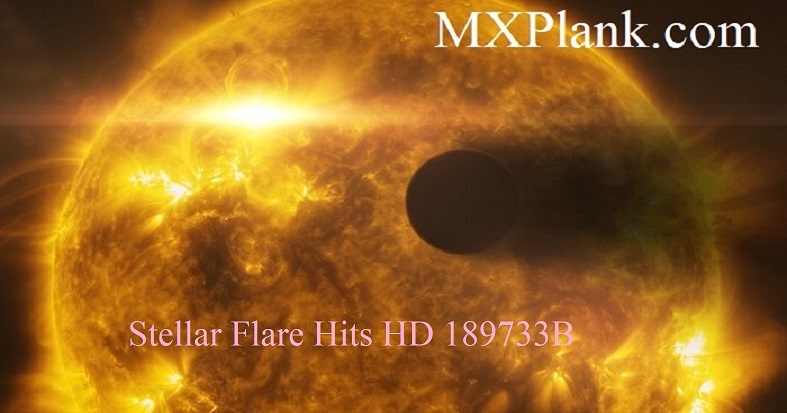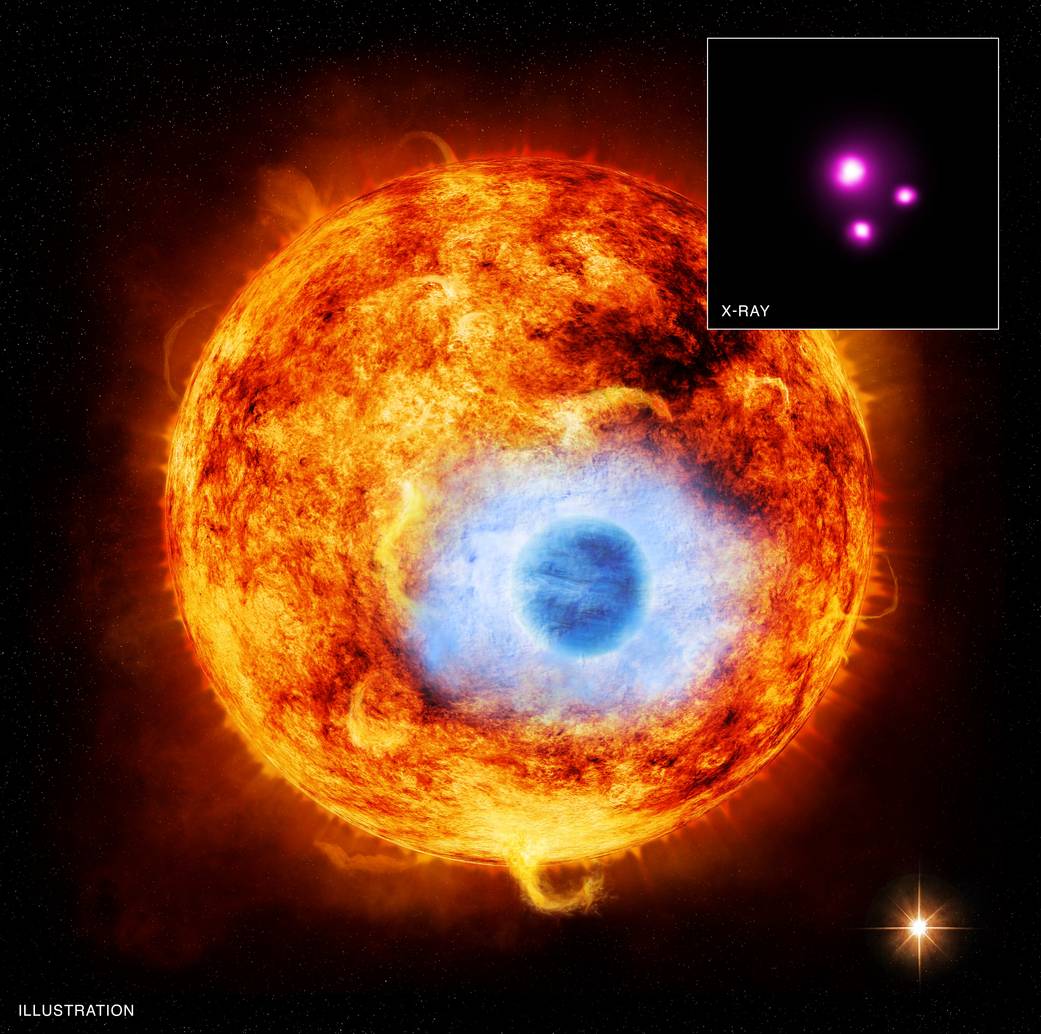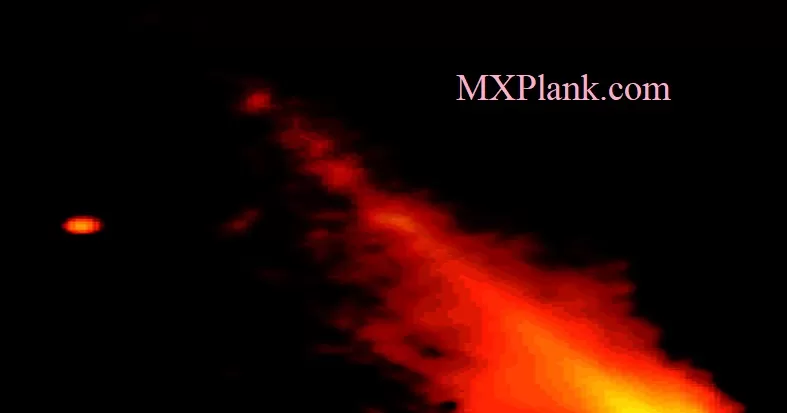Stellar flare hits HD 189733B

HD 189733 B is an exoplanet approximately 64.5 light-years away from the Solar System in the constellation of Vulpecula.
The planet was discovered orbiting the star HD 189733 on October 5, 2005, when astronomers in France observed the planet transiting across the face of the star.
With a mass 16.2% higher than that of Jupiter and a radius 13.8% greater, HD 189733 b orbits its host star once every 2.2 days at an orbital speed of 152.5 kilometres per second (341,000 mph), making it a hot Jupiter with poor prospects for extraterrestrial life.
Being the closest transiting hot Jupiter to Earth, HD 189733 B is a subject for extensive atmospheric examination.
The atmosphere of HD 189733B has been extensively studied through high- and low-resolution instruments, both from ground and space.
HD 189733 B is the first extrasolar planet for which a thermal map was constructed, possibly to be detected through polarimetry, to have its overall color determined (deep blue), to have a transit detected in X-ray spectrum and to have carbon dioxide detected in its atmosphere.
This image shows exoplanet HD 189733B, as it passes in front of its parent star, called HD 189733A. Hubble's instruments observed the system in 2010, and in 2011 following a large flare from the star (depicted in the image). Following the flare, Hubble observed the planet's atmosphere evaporating at a rate of over 1000 tonnes per second. In this picture, the surface of the star, which is around 80% the mass of the Sun, is based on observations of the Sun from the Solar Dynamics Observatory.

In this image, the nightmare world of HD 189733 b is the killer you never see coming. To the human eye, this far-off planet looks bright blue. But any space traveler confusing it with the friendly skies of Earth would be badly mistaken. The weather on this world is deadly. Its winds blow up to 5,400 mph (2 km/s) at seven times the speed of sound, whipping all would-be travelers in a sickening spiral around the planet.
And getting caught in the rain on this planet is more than an inconvenience;it's death by a thousand cuts. This scorching alien world possibly rains glass-sideways-in its howling winds. The cobalt blue color comes not from the reflection of a tropical ocean, as on Earth, but rather a hazy, blow-torched atmosphere containing high clouds laced with silicate particles.
The alien planet HD 189733B is a beautiful blue dot in a sea of inky blackness, just like Earth. But that's where the similarities between the two worlds end.
For starters, HD 189733B is much bigger and hotter than Earth; it's about the size of Jupiter and zips around its host star in just 2.2 Earth days. That orbit is so close that the exoplanet is probably tidally locked, always showing one face to its star, just as the moon always shows one face (the near side) to Earth.
And then there's the weather. The winds on HD 189733B (which lies about 63 light-years from Earth, in the constellation Vulpecula) blow at up to 5,400 mph (8,700 km/h) - about seven times the speed of sound. And if that's not crazy enough for you, scientists think the rain on this world is made not of water, but of molten glass.
Why, then, does this bizarre planet appear so superficially Earth-like? It's just a coincidence, scientists said.
"The cobalt blue color comes not from the reflection of a tropical ocean, as on Earth, but rather a hazy, blow-torched atmosphere containing high clouds laced with silicate particles," NASA officials wrote in a statement.
There may be a lot of ocean-free blue planets out there. Indeed, scientists know of two in Earth's own solar system: Uranus and Neptune. The upper atmospheres of both of these "ice giants" contain methane, which reflects blue wavelengths of sunlight back into space.
HD 189733B was discovered in 2005, and scientists figured out its color in 2013 using NASA's Hubble Space Telescope and other instruments. The exoplanet is one of six highlighted in NASA's "Galaxy of Horrors," a special Halloween gallery that the space agency put together

This graphic depicts HD 189733B, the first exoplanet caught passing in front of its parent star in X-rays. As described in our press release , NASA's Chandra X-ray Observatory and the European Space Agency's XMM Newton Observatory have been used to observe a dip in X-ray intensity as HD 189733B transits its parent star.
The main figure is an artist's impression showing the HD 189733 system, containing a Sun-like star orbited by HD 189733B, an exoplanet about the size of Jupiter. This "hot Jupiter" is over 30 times closer to its star than Earth is to the Sun and goes around the star once every 2.2 days, as determined from previous observations. Also in the illustration is a faint red companion star, which was detected for the first time in X-rays with these observations. This star orbits the main star about once every 3,200 years.
The inset contains the Chandra image of HD 189733. The source in the middle is the main star and the source in the lower right is the faint companion star. The source at the bottom of the image is a background object not contained in the HD 189733 system.
The exoplanet itself cannot be seen in the Chandra image, as the transits involve measuring small decreases in X-ray emission from the main star. The authors estimate that the percentage decrease in X-ray light during the transits is about three times greater than the corresponding decrease in optical light. This tells them that the region blocking X-rays from the star is substantially larger than the region blocking optical light from the star, helping to determine the size of the planet's atmosphere.
The extended atmosphere implied by these results is shown by the light blue color around the planet. Recent observations of HD 189733B with the Hubble Space Telescope have confirmed that the lower atmosphere of the planet has a deep blue color, due to the preferential scattering of blue light by silicate particles in its atmosphere.
For about a decade astronomers have known that ultraviolet and X-ray radiation from the main star in HD 189733 are evaporating the atmosphere of its closely orbiting planet over time. The authors of the new study estimate that HD 189733B is losing between 100 million and 600 million kilograms per second. This rate is about 25% to 65% higher than it would be if the planet's atmosphere were not extended.
At a distance of just 63 light years, HD 189733B is the closest hot Jupiter to Earth, which makes it a prime target for astronomers who want to learn more about this type of exoplanet and the atmosphere around it.
Chandra was used to make observations of six transits by HD 189733B and the team also used archival data from XMM-Newton for one transit. These results are available online and will appear in the August 10th issue of The Astrophysical Journal.
Credit:
NASA, ESA, L. Calcada
Credit: X-ray: NASA/CXC/SAO/K. Poppenhaeger et al; Illustration: NASA/CXC/M. Weiss






